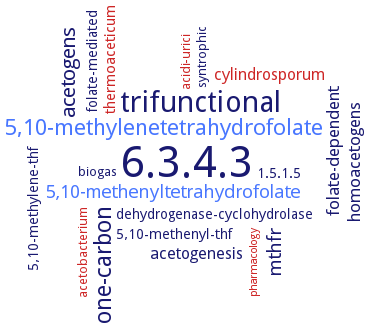6.3.4.3: formate-tetrahydrofolate ligase
This is an abbreviated version!
For detailed information about formate-tetrahydrofolate ligase, go to the full flat file.

Word Map on EC 6.3.4.3 
-
6.3.4.3
-
trifunctional
-
one-carbon
-
5,10-methylenetetrahydrofolate
-
acetogens
-
mthfr
-
5,10-methenyltetrahydrofolate
-
homoacetogens
-
folate-dependent
-
acetogenesis
-
cylindrosporum
-
thermoaceticum
-
folate-mediated
-
1.5.1.5
-
dehydrogenase-cyclohydrolase
-
5,10-methenyl-thf
-
5,10-methylene-thf
-
biogas
-
acetobacterium
-
acidi-urici
-
syntrophic
-
pharmacology
- 6.3.4.3
-
trifunctional
-
one-carbon
- 5,10-methylenetetrahydrofolate
-
acetogens
- mthfr
- 5,10-methenyltetrahydrofolate
-
homoacetogens
-
folate-dependent
-
acetogenesis
- cylindrosporum
- thermoaceticum
-
folate-mediated
-
1.5.1.5
-
dehydrogenase-cyclohydrolase
-
5,10-methenyl-thf
-
5,10-methylene-thf
-
biogas
- acetobacterium
- acidi-urici
-
syntrophic
- pharmacology
Reaction
Synonyms
10-CHO-THF synthase, 10-formyl-THF synthetase, 10-Formyltetrahydrofolate synthetase, 10-formylTHF synthetase, ADE3, C(1)-tetrahydrofolate synthase, C1 synthase, C1-tetrahydrofolate synthase, C1-tetrahydrofolate synthetase, C1-THF synthase, C1-THFS, CpeFhs, DCS, dehydrogenasse-cyclohydrolase-synthetase, FHS, formate-tetrahydrofolate ligase, formate:tetrahydrofolate ligase (ADP-forming), formyl tetrahydrofolate synthetase, Formyl-THF synthetase, Formyltetrahydrofolate synthetase, ftfL, FTHFS, FTL, methylenetetrahydrofolate dehydrogenase 1-like, methylenetetrahydrofolate dehydrogenase-methenyltetrahydrofolate cyclohydrolase-formyltetrahydrofolate synthetase, methylenetetrahydrofolate dehydrogenase-methenyltetrahydrofolate cyclohydrolase-formyltetrahydrofolate synthetase enzyme, MIS1, MTHFD, MTHFD1, MTHFD1L, MTHFDIL, N10-formyltetrahydrofolate synthetase, NAD-dependent methylenetetrahydrofolate dehydrogenase, Synthetase, formyl tetrahydrofolate, Tetrahydrofolate formylase, Tetrahydrofolic formylase, THF synthase, THFS


 results (
results ( results (
results ( top
top





